8 Use Examples of NFT in Travel and What is Coming Next

The travel sector heavily relies on both hardware and software innovations. With the help of technology, travel organizations can streamline everything from online booking to personalized offers. Some major technology advancements are even capable of transforming the entire sector. Such is the case with travel NFT.
The chances are that you are hearing about travel NFT for the first time. It’s an emerging tech that is intertwined with tourism. But what is it? How can the travel sector benefit from it? Is it here to stay? Below you can find answers to all these pressing questions, including some real-life examples of NFT applied to travel.
What is NFT?
NFT stands for a non-fungible token. NFT is not a cryptocurrency but related to it as NFTs can often be bought and sold with cryptocurrency. Non-fungible tokens are digital assets or “goods,” if you prefer. They can represent several things or objects from the real world, including music, videos, in-game items, items in a virtual world, or art.
The technical definition of NFT goes along the following lines:
“NFT is a financial security consisting of cryptographic assets on a blockchain.”
It simply means that they are well-protected digital assets people can trade among themselves while they remain secure and backed up by blockchain technology. In many cases, NFTs are encoded by the same blockchain that runs beneath popular cryptocurrencies such as Ethereum and Bitcoin.
NFTs are not a “brand-new” invention – they have been around since 2014. However, during the last couple of years, many people started using them to trade digital art. The NFT market in 2021 exploded, reaching a value of over $40 billion.
Since the number of tokens in an NFT collection is limited, the digital scarcity often follows their release, which reflects the NFT’s price range often skyrocketing and reaching incredible values.
Facebook’s rebranding into Metaverse also brought NFTs into the spotlight. All of a sudden, it was clear that NFTs can be used in virtual spaces such as Metaverse to buy virtual real estate and other virtual spaces and experiences.
With all this in mind, one can barely make the connection between NFT and the travel industry, yet travel NFT is a thing. Let’s take a closer look at it.
4 ways the travel industry can benefit from NFT technology
The travel sector is still reluctant to implement and use NFTs. Before travel companies can depend on NFTs in their day-to-day operations and add an NFT sightseeing icon or booking icon to their sites, they need to discover its benefits.
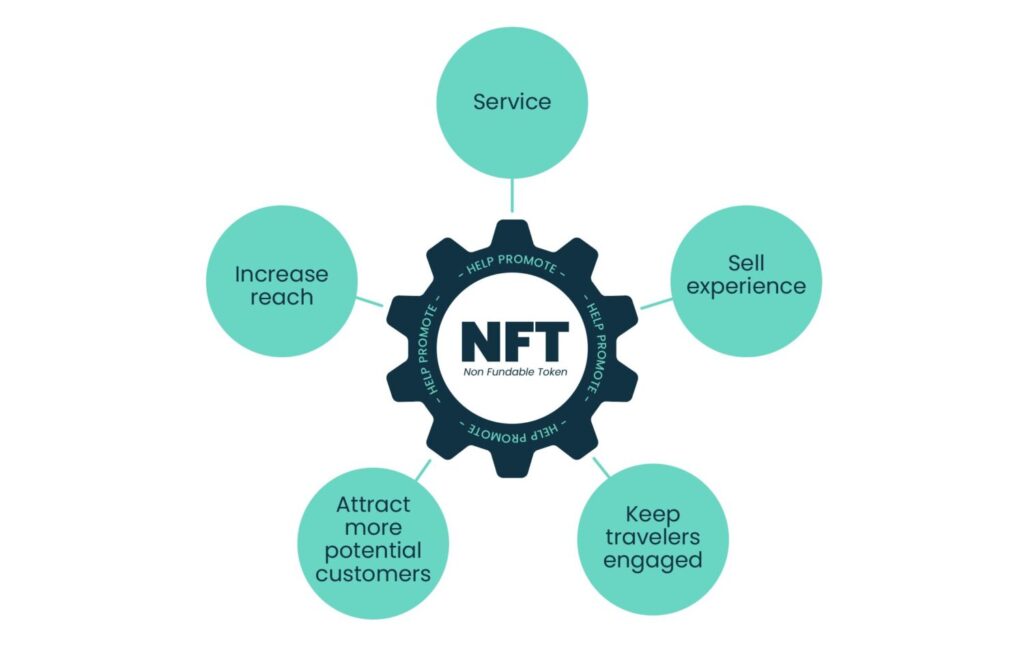
Knowing all the benefits can help you decide whether to start using NFT if your market research reports indicate that there is a demand for it. Here are some of the noteworthy advantages NFT tech offers to the sector.
Improved marketing
If there is one thing that we can say for sure about NFTs, it is that they can create a massive buzz. It’s not something that only tech-savvy travelers know about. The fact that the NFT sales increased by 21,000% over 2020 is more than enough to understand how popular this technology is.
Travel companies can benefit from this popularity by adding NFTs to their marketing mix. They can create collectible NFTs to get some attention from the news portals. It can help them increase their reach, attract more potential customers, and highlight brand identity traits such as creativity.
Destination Management Organizations (DMOs) can leverage NFTs as well. For instance, they can partner with artists at destinations and help them mint their art and create limited edition NFT collections, which they can then offer to visiting businesses.
Improving the travel experience to be more engaging
Location-based NFTs can help travel agencies to track, record, and store travelers’ movement while exploiting destinations on a blockchain. The best thing about this process is that blockchain makes sensitive data safe.
This NFT’s capability can help organizations improve the travel experience. Imagine enabling all your clients to track their exploration. With NFT, your clients can track their movement to ensure they’ve participated in all activities and visited all sites listed in the itinerary. Besides NFT sightseeing, they can treasure their favorite moments by recording videos or taking shots and storing them on the blockchain.
Driving engagement rates
Travel agencies and tour operators have limited options for driving engagement rates, especially at the destination. It’s practically limited by the number of fun, entertainment, wellness, hospitality, and leisure venues at a location. Also, some destinations offer more sights than others. NFT can help overcome this challenge and improve engagement even in less-attractive destinations.
Since NFTs can store GPS information, travel organizations can use NFTs to organize and launch scavenger hunts for travelers at destinations. NFT lets travelers easily prove they’ve visited outlined locations or participated in required activities. It can help companies drive engagement rates and get more social media mentions as travelers like to share their achievements.
Ensuring repeat business
The repeat business is what keeps the travel industry going forward. Companies of all sizes in this sector want to build long-lasting relationships with their clients and ensure they use their services the next year around. That’s exactly why many travel companies have a loyalty program. NFTs can help enhance this initiative and ensure repeat business.
Travel companies can use NFTs to reward travelers who complete activities and visit certain places. The rewards can be something as simple as discounts. Since NFTs enable storing information, companies can also reward points their clients can use to cash in whenever they want.
Real-life examples of NFT applied to travel
The concept of travel NFT is not as far-reaching as you might have thought. Some travel companies and hotels are already using NFTs to achieve various goals. Let’s see a couple of real-life examples of NFT applied to travel.
Marriott’s Power of Travel campaign
Marriott International has established itself as a leader in adopting new technologies. When it comes to hotels, Marriott is the first one to start using NFT technology. It all started when Marriot Bonvoy started a collaboration with Erick Nicolay, JVY, and TXREK. These three renowned digital artists were hired to create artwork using the Marriott marketing campaign as inspiration.

The concept they used for inspiration was embedded in the Power of Travel campaign, and they were asked to create digital art, which was minted as NFTs.
Tarek Mustapha, a.k.a TXREX, created MΞMORIED NFT. The artist connected the destination experiences to create a sense of adventure. To make the experience even more engaging, the NFT includes Marriott Bonvoy’s path connector. Viewers can use it to explore different pathways to almost 8,000 properties listed in the Marriott Bonvoy Portfolio.
Jared “Jay” Richardson, a.k.a JVY, created the Emotional Journey NFT. He was inspired by the environmental capacity to evoke strong emotions. This digital art encompasses three environments at different points in time. The viewers can feel lost in a natural forest or experience destinations that are nothing but perfect.
Finally, Erick Nicolay created the EXPERIENTIAL IN BETWEEN NFT. Mixing together the experiences of outdoor and indoor traveling, the artist managed to create a unique 3D surrealistic impression.
Marriot surprised the guests during the Art Basel Miami Beach event in 2021, giving the NFTs away. In terms of marketing, it was an excellent strategy by Marriot. Dozens of leading news portals picked up the story and featured the hotel all over the news. The artists also got more exposure.
Travala’s Travel Tiger Club
When Travala started using NFTs, it didn’t come as much of a surprise. While Travala is an online travel booking platform, it’s also one of the renowned online travel agencies based on blockchain. Its customers can browse over 90,000 destinations in the company’s listings and pay in cryptocurrencies.
Given that the company has profound experience in using blockchain tech, it felt natural for them to capitalize on the popularity of NFTs. They decided to leverage NFT to enhance their travel marketing campaign.
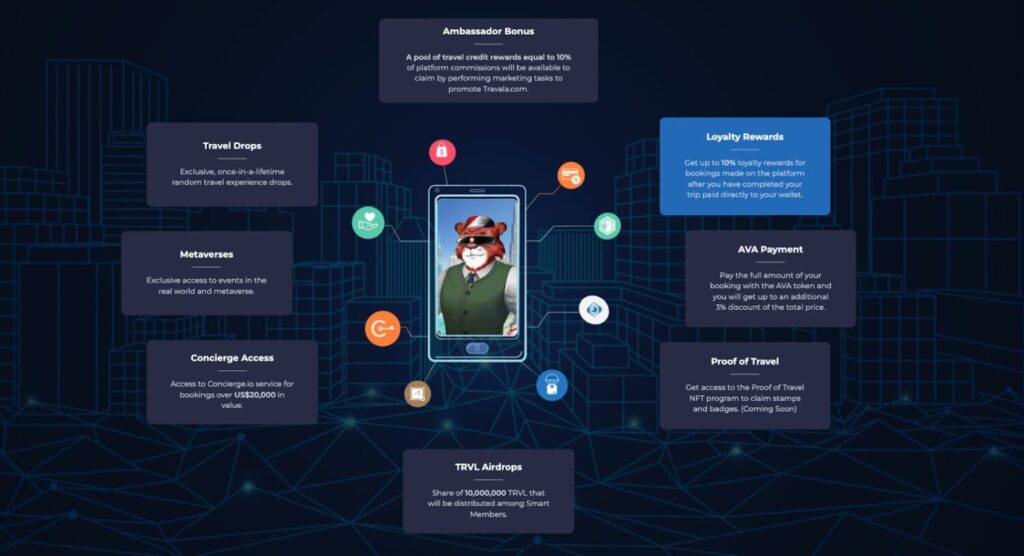
The Founders Edition Travala.com “Travel Tigers” NFTs are a collection of 1,000 unique, randomly generated utility NFTs living on the Ethereum blockchain.
They did it through the Travel Tiger travel club, enabling all the members to purchase a unique NFT. The NFTs acted as keys allowing members to unlock Smart Diamond rewards, including points, bonuses, and discounts.
Every Traveling Tiger featured in the NFT collection is a nomadic traveler and comes with unique characteristics. These NFTs work in combination with AVA which is a multi-chain token. It is based on the Binance Smart Chain (BEP-20), Binance Chain (BEP-2), and Ethereum blockchain (ERC-20).
Once a traveler becomes a member of Travala’s Smart Diamond club, they can receive giveback rewards paid in AVA. To unlock the Smart Diamond status, travelers need a Travel Tiger NFT and 2,500 AVA. The Smart Program offers a wide range of rewards, including Smart Discounts, Proof of Travel, Travel DRops, Exclusive Access, Concierge Access, and many others.
Galileo Travel Futures Club
Galileo has launched a brand new Travel Futures club to help the travel sector recuperate after the losses during the pandemic. The club is based on blockchain technology. Clients can buy $TRVL tokens. But where does NFT fit in here? Galileo has introduced NFTs to enable customers to mint the trips they’ve purchased with $TRVL tokens.
$TRVL tokens alone provide numerous benefits, and the only requirement is to hold and stack them. For instance, you can receive:
- Additional spa and experience vouchers every month
- 15% discount on vouchers
- Free travel vouchers if you build up your Travel Score
In this instance, NFT represents an entire travel experience that clients can redeem in the next 3 to 5 years. However, the clients don’t have to redeem them immediately – they are free to resell them for a profit. The goal is to enable the industry to continue generating profits, remove the risk of cancelation fees, and provide travel agencies and travelers with peace of mind.
The Galileo Travel Future Club currently only includes Bali as a destination for NFT holders. However, the company is currently working on adding other destinations, including Thailand, Malaysia, Saudi, Turkey, and Italy.
Given the numerous cybersecurity threats, the Travel Futures Club offers free access to the Travel Futures Wallet. It provides a safe and secure way to store your Travel Assets until you decide to use or sell them.
Dream Hollywood Hotel
Here is yet another use case of NFTs in travel marketing. You’ve probably heard of Dream Hollywood Hotel as it is among the most popular venues in Los Angeles. To become competitive and stand out from the crowd, the hotel decided to start using NFT technology.
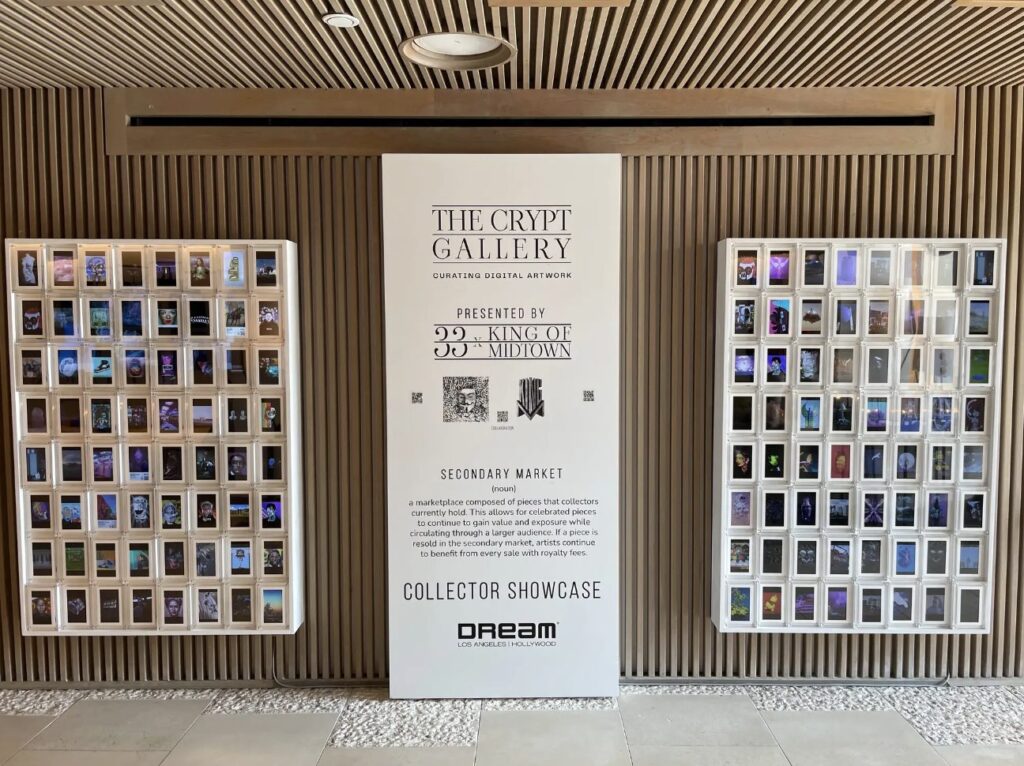
The Dream Hollywood hotel opened an NFT art gallery in its lobby.
The hotel became the first hotel in the world to host an NFT art exhibition. The hotel started working with The Crypt Gallery, a partnership that enabled it to host an NFT exhibition in its lobby. The hotel also has staff in the lobby to educate visitors about NFT, its benefits, and how to apply it.
Furthermore, this luxury, lifestyle boutique hotel launched its first VIP membership program, “Social Club,” basing it entirely on NFTs. The limited edition NFT collection will enable people to become VIP members. All the benefits of the program are exclusively tied to the NFT. The benefits include metaverse activations, the Gunnar Peterson Gym access, private events with the Crypt Gallery, poolside lounge chairs, expert concierge, Lincoln luxury house cars, and many others.
Additionally, members of the Social Club receive a complimentary one-night stay in a luxury suite and a 10% discount on hotel rooms and weekday poolside cabanas. NFT holders are free to sell their NFTs along with all the membership benefits that go with them.
Ca Di Dio
Ca Di Dio is a hotel in Venice, Italy, that caters to guests attracted to luxury venues. Recently the hotel started using NFT technology even before officially opening its doors to guests. It proved to be an excellent marketing strategy.
The hotel organized an auction for the NFT, where the holder of the NFT got some exclusive perks. For instance, the auction winner got a chance to spend a night in Ca Di Dio completely alone and experience it before anyone else was allowed to visit or stay. More specifically, the NFT offered access to:
- A stay in the most prestigious room
- Dinner on the roof terrace (view of the lagoon and San Giorgio)
- Private boat transfer to the hotel
The hotel put the NFT on auction and sold it for 1 ETH, which roughly translates to $3.280. This proved an excellent strategy given that Ca Di Dio is a luxury hotel, and guests who enjoy these venues value the exclusivity above anything else. The NFT and the auction turned out to be an excellent marketing strategy used to boost brand awareness and reach out to many potential guests.
AirBaltic
AirBaltic is perhaps the first airline based in Latvia to use NFTs to promote its services and attract more clients. At the same time, the company used NFTs to promote the tourist destinations in Latvia, including some of the country’s most attractive cities.
AirBaltic created NFT art tokens inspired by Latvia’s major cities and held an auction selling these collectible NFTs. Since the campaign was successful, AirBaltic decided to launch the Planies NFT collectibles, which serve as tokens customers earn through the customer loyalty program.
The Plaines NFT collection includes 10,000 unique cartoon aircraft designs. This NFT collection will help frequent flyers save additional cash, further incentivizing them to stay with the company. To motivate the customers to buy tokens, AirBaltic decided to link the NFT collection to the airBaltic Club and reward points to members of the Club who are also NFT holders.
Given the harsh competition in the airliners sector, AirBaltic’s move is bound to ensure repeat business with customers while also enabling them to collect unique NFTs which they can trade along with the benefits they provide.
Travel Lucky Ape
Regarding NFT collections specifically launched for metaverse enthusiasts and travelers, Travel Lucky Ape takes the lead. It is the first NFT collection that gives travelers access to boutique hotels worldwide.
Travel Lucky Ape features over 10,000 NFTs. It was created on the immensely popular Ethereum blockchain, and holders of these NFTs can also attend community parties at exotic locations. They can use the NFTs to access other benefits inside the Metaverse too.
The Lucky Ape Travel Club NFT acts as an exclusive club membership card. Holders can freely trade or sell it. What makes Travel Lucky Ape NFT unique is that it caters to travelers interested in visiting and experiencing exotic locales such as isolated, beautiful manors and yacht parties.
NFT holders can access The Odyssey Lounge, which serves as a portal that enables travelers to access a destination with their NFT. It works as an online reservation system that accepts only NFTs as payment. The only limit is that you can book a stay for up to 7 days. The destinations available through the Lucky Ape travel club include:
- Miami, USA
- Tulum, Mexico
- Island near Punta Gorda, Belize
- Rio De Janeiro, Brazil
- Sosua, Dominican Republic
- Bali, Indonesia
- Istanbul, Turkey
Flyfish Club
It appears that NFTs can also help the hospitality sector. Flyfish Club (FFC) is a New York-based restaurant and among the first restaurants to start using NFT technology. In fact, the restaurant went so far as to issue membership cards as an NFT.
Customers can only purchase Flyfish Club membership cards with cryptocurrency. All FFC members have access to a private dining room at a great New York City location, which includes an intimate omakase room, beautiful cocktail lounge, outdoor space, and upscale restaurant, all spanning more than 10,000 square feet.
The restaurant allows only its NFT holders to access the premises, but the members can still sell or lease their NFTs to others. To claim exclusive access to FFC, NFT holders have to create a member profile at the FFC official site and verify the ownership of their token by connecting their wallets.
There are two types of NFTs – Flyfish token and Flyfish Omakase token. With the Flyfish token, guests can access the restaurant and cocktail lounge, while Flyfish Omakase token holders can also access the exclusive Omakase room. The NFT doesn’t pay for the food, though. It only covers the cost of entry. NFT holders will still have to pay for food in US dollars.
The future of NFT in travel: where is it now and where it’s heading
As you can see, there are a lot of interesting new developments in the NFT travel space. Airliners, hotels, and travel companies use NFTs to promote their services, sell experiences, keep travelers engaged, and create attractive loyalty programs.
While this proves that NFTs can be used in the travel sector, there are still some skeptics out there. They argue that the demand for NFTs is still uncertain and that many travel companies are still not sure how NFTs can benefit them.
Conclusion
If we only consider the current developments, it’s safe to assume that NFT technology has a bright future in the travel sector. Travel companies, including hotels, leverage NFTs to achieve various goals.
While they use NFTs mainly for marketing, some use NFTs to enable attractive loyalty programs and sell travel experiences. However, we will have to wait for the NFT craze to subside to see whether the NFT adoption rates will continue to increase.
Subscribe to
our newsletter
Yay! You are now
subscribed to our
newsletter
Mize is the leading hotel booking optimization solution in the world. With over 170 partners using our fintech products, Mize creates new extra profit for the hotel booking industry using its fully automated proprietary technology and has generated hundreds of millions of dollars in revenue across its suite of products for its partners. Mize was founded in 2016 with its headquarters in Tel Aviv and offices worldwide.
Related Posts
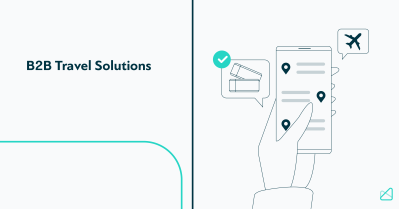
Your Ultimate Guide to B2B Travel Solutions
17 min. You’ve probably noticed that B2B travel solutions play a vital role in the global B2B travel sector. We are talking about the market bound to reach the size of $4952.96 by 2028. That’s a CAGR Growth of 17.51%. No wonder leading B2B travel solutions process over 80.000 bookings and 14.000 searches a day. […]
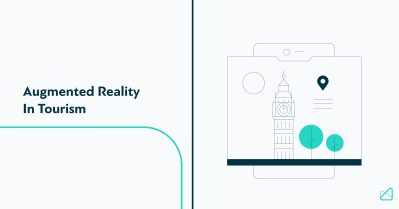
5 Ways Augmented Reality is Enhancing the Tourism Experience
20 min. Augmented reality (AR) can truly transform the way people discover and explore new places. By combining physical exploration with digital elements, travelers are able to gain deeper insights into different cultures while making memories along the way. In today’s world, more and more travelers are turning to technology to add excitement and convenience […]

Everything You Need to Know About Virtual Tourism Companies
24 min. Virtual tourism refers to a specific tourism niche using technology that enables travelers to experience activities, locations, and destinations without leaving their homes. The types of virtual tours depend on the multimedia format offered to travelers. It can be anything ranging from still images, video, and audio to interactive virtual reality. The popularity […]
